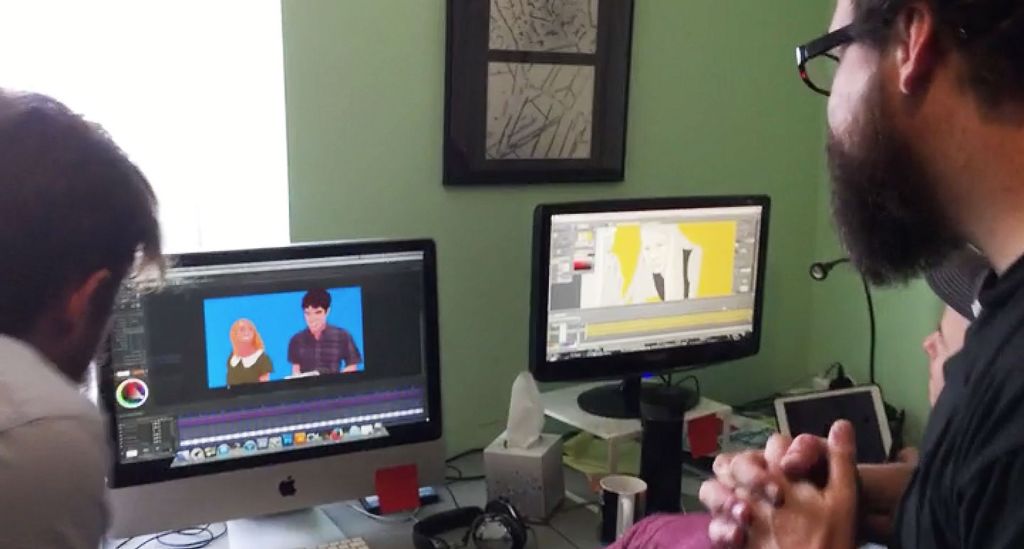Craig Staggs is the lead animator for the little animation studio based in Austin, Texas, also the home base of filmmaker Keith Maitland. Staggs’ company did the brilliantly layered animation for Maitland’s film TOWER. Of that film which tells the story of the heroes and victims who were on the University of Texas campus that fateful August day in 1966, David Edelstein wrote in his review for NPR, “we’re on such intimate terms with Maitland’s subjects that when the faces of the real, aged people burn in over their younger animated counterparts, the effect is unspeakably moving.”
The film’s unique look and production style used both actors (quoting real dialogue from the real-life survivors) and dramatic recreations, animated rotoscopically, all woven together with interviews with the actual people and archival footage. From start to finish this unique production’s process took about 18 months to complete.
Viewers surely will wonder, as I did, how much of the film’s animation is straight computerized, and did the use of technology make it harder for the artists involved to feel connected to the emotional core of this story?
“I’ll say it like this: we don’t hire software engineers,” Staggs told us. “We hire artists. The computer and software are just tools. We use them the same way a writer uses a computer to create a script or an editor uses a computer to cut a film. The computer, in our case, is replacing the animation equipment you find in a traditional studio with digital tools like software or digital cameras. Each shot was created by a team of artists using a digital pen as brush, the computer as canvas and their intellect as the creative engine.”
That canvas that Staggs’ team uses is a French animation program called TVPaint. “One great thing about the studios using this software is that none of our films look remotely alike,” Staggs said. “It’s a testament to the power of the artist’s hand in this type of animated film-making.” Each shot is composed of several layers, from background up to the characters, and then foreground and special effects layers added on top. About four or five animators would work on each shot as the clip made its way from design to production.
Before doing his own thing as an animator, Staggs gained valuable experience working on Richard Linklater’s groundbreaking rotoscoped sci-fi, A Scanner Darkly. “Scanner was a lesson in how hard it is to actually make an animated film,” Staggs said. “Even making a film with a seemingly sufficient budget and amazing crew can be filled with unpredictable struggles and pitfalls. I never thought TOWER was not going to be hard. I built a team that could roll with that. And we got what we expected. It was a hard movie to make, but it was important and we persevered.”
For TOWER‘s own aesthetic, Staggs told me that their conversations and visual vocabulary started with A Scanner Darkly, as well as director Keith Maitland’s previous film, The Eyes of Me, “and some rotoscoping he’d developed for commercial work. “Then we quickly moved into creating a look and feel that was unique to this project and continued to develop that throughout production.”
I asked Staggs what he and his team tried to be mindful of when working on this true life piece that touches on a really painful experience for the people in it. To explain how they approached it, Staggs also sent the introduction to the film project that he wrote and asked everyone to read on their first day working at the studio:
We are creating an historical document about a crime. We won’t take it lightly by taking shortcuts… Our visuals will reflect both the serious significance of the event and the trust the subjects of the film place in us, the filmmakers. We aim to portray emotion—the feelings experienced by the subjects—in the artwork we produce. And we aim for more. We are going to look past the awful and into the beauty where possible.
Our styles will be refined and graceful… It will be challenging to animate and beautiful when done right. Our animation software does not smooth our lines, choose our shapes, or interpolate between frames—we are in all ways drawing this animation by hand. Our goal is a sophisticated visual style that pays somber homage to our survivors while elevating the audience’s visual experience. And like any survivors’ story we will search for moments to show the beauty and value in life before, during, and after tragedy.
Since their studio is just a few blocks from the University of Texas campus, the Minnow Mountain team used that access to add a real immediacy to the film.”We use a collage approach to fold into digital paintings, video and photographic assets inspired by and captured on the [campus] grounds,” Staggs said. “In many cases using site-specific video and photography to place our animated characters in the same place their true-life counterparts were some fifty years ago.”

